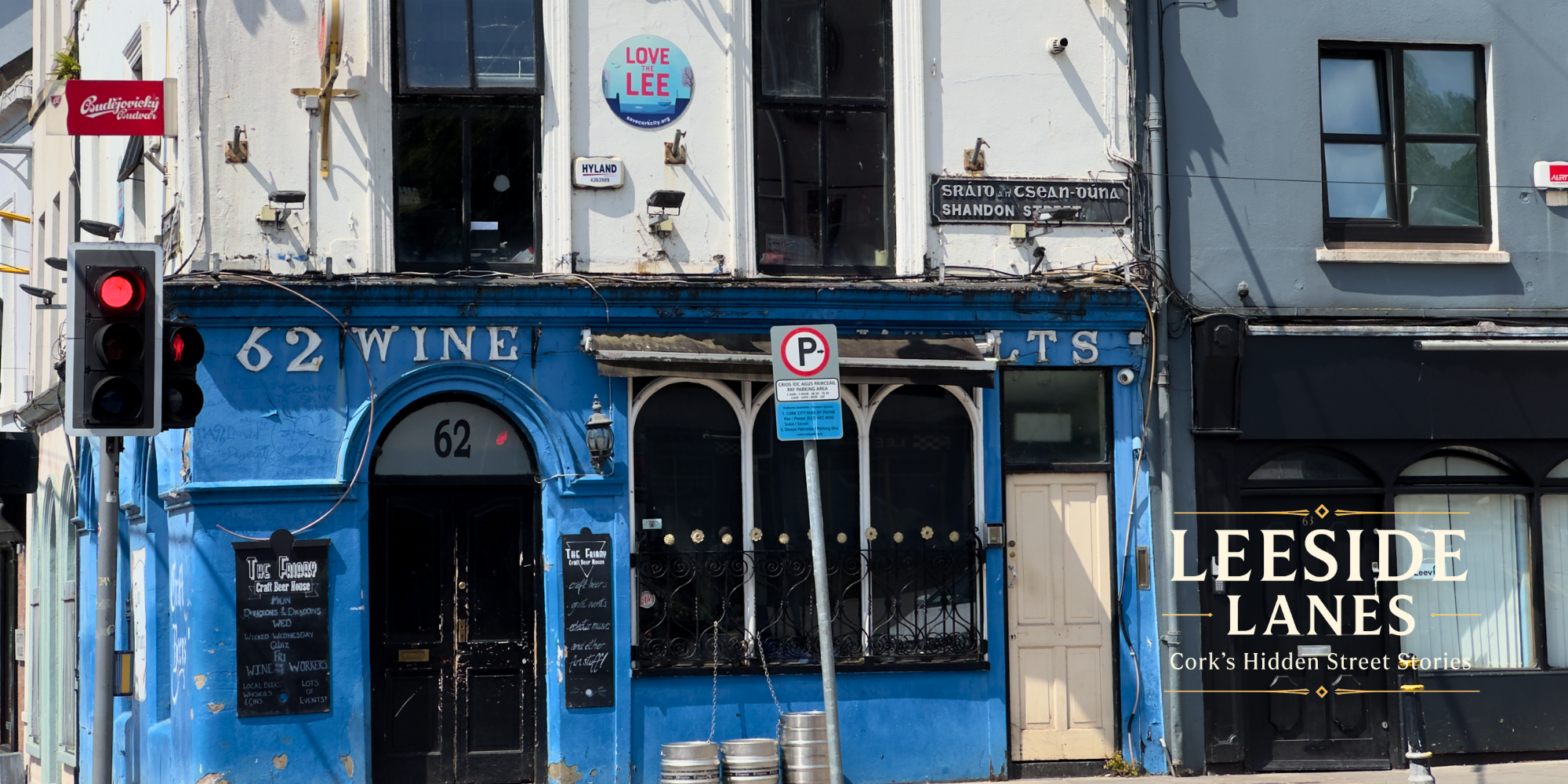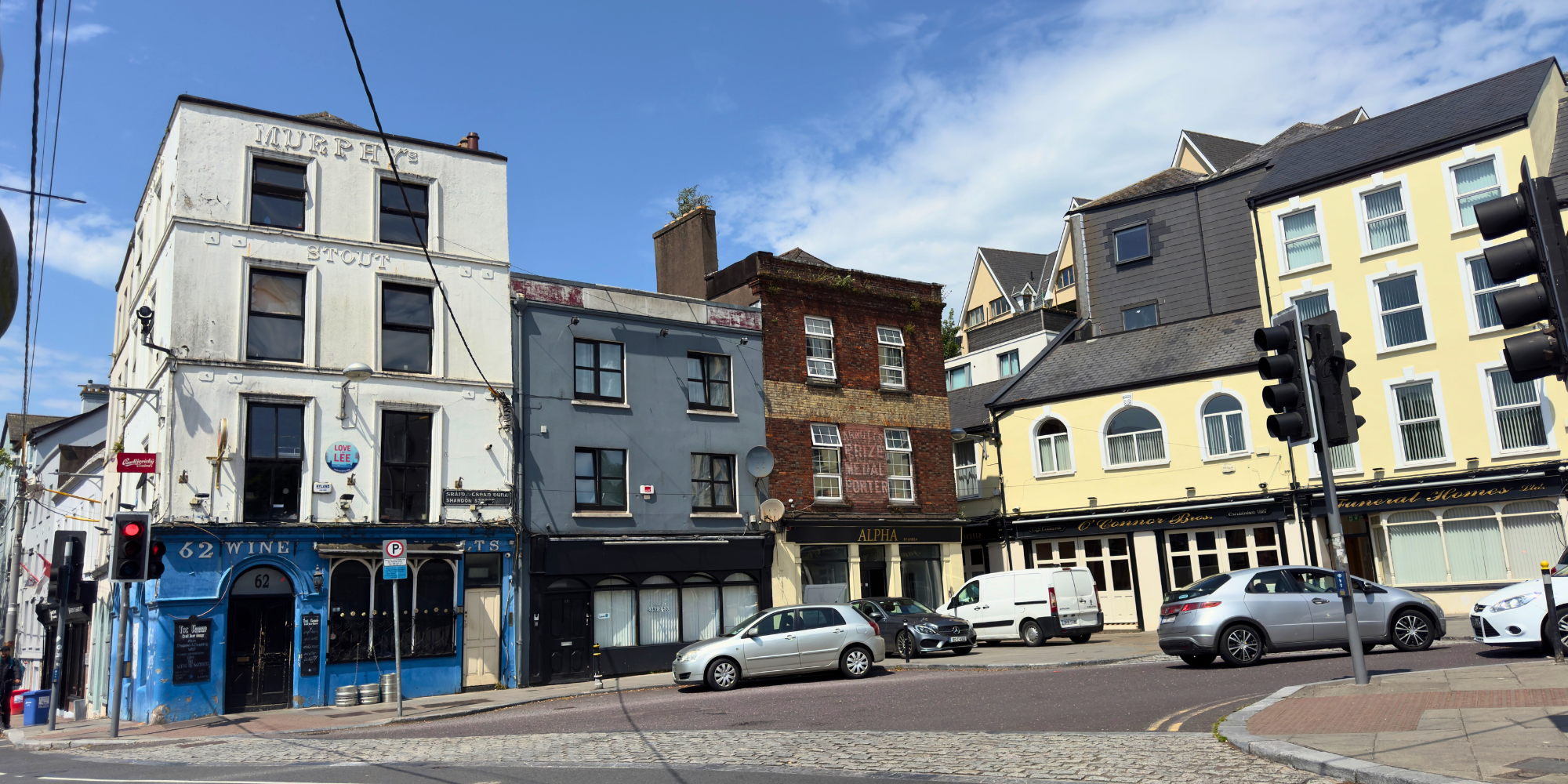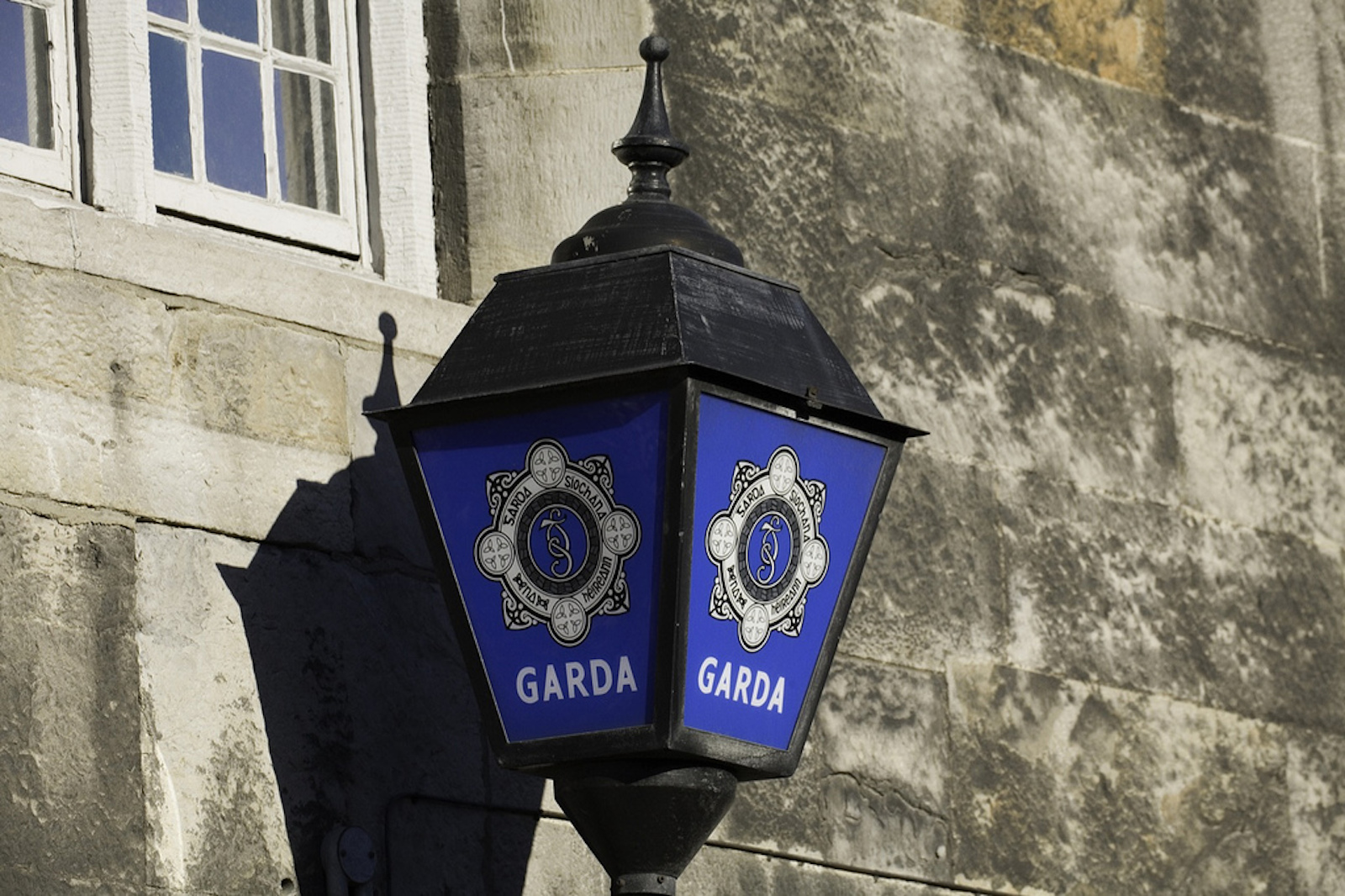Shandon Street: Where Cork's Ancient Heart Still Beats Through Butter, Bells and Business
The street named for an ancient fort now hosts tech hubs in butter warehouses. Shandon Street: Where Cork's 1750 church bells ring above 2025 EuroMillions jackpots daily.

- Eight centuries of history echo through Cork's iconic northside thoroughfare, from medieval fortress to global butter empire to modern multicultural marketplace, as EU-funded regeneration meets family businesses keeping tradition alive beneath the famous two-toned steeple.
Leeside Lanes continues...
The climb up Shandon Street tests the legs but rewards the soul. This steep northside artery has been Cork's pulse for over 800 years, rising from the River Lee towards the distinctive red and white tower of St Anne's Church, whose bells have marked time through conquest, commerce and community resilience.
From its origins as a medieval route called Mallow Lane to its golden age as the epicentre of the world's largest butter market, Shandon Street embodies Cork's remarkable journey. Today, traditional sweet makers work alongside African grocery stores, while EU funding promises regeneration for a street where history isn't just remembered: it's lived daily by those who call it home.
From Ancient Fort to Urban Gateway
The very name Shandon reveals deep roots, deriving from the Irish "Sean Dún" meaning "old fort." Archaeological evidence suggests the MacCarthy clan established a ringfort on this strategic hilltop around 1000 AD, commanding views over the marshy islands where Cork would grow.
When Anglo-Norman settlers arrived in the 13th century, they recognised the route's strategic importance. They formalised the ancient path as Mallow Lane, creating a vital connection to the North Gate Drawbridge, one of only three entrances to the medieval walled city. This wasn't merely a street but a lifeline, channeling trade, troops and travellers between Cork and the northern countryside.
The construction of Shandon Castle between 1599 and 1600 on the site of the old MacCarthy fort reinforced the area's military significance. The castle served as residence for English administrators and housed criminal courts during the turbulent Munster Plantation period, symbolising colonial authority over the region.
Destruction and Rebirth: The 1690 Watershed
The 1690 Siege of Cork marked a violent turning point that would paradoxically enable Shandon's greatest transformation. Williamite forces devastated the area, destroying both Shandon Castle and the medieval St Mary's Church. Yet from these ashes rose the landmarks that define Cork's skyline today.
St Anne's Church emerged between 1722 and 1726, its builders displaying remarkable pragmatism by recycling history itself. They used red sandstone from the demolished castle for the north and south faces, while white limestone from a ruined Franciscan abbey formed the east and west walls. This created the distinctive "party-coloured" appearance that inspired the rhyme: "Party-coloured, like the people, red and white stands Shandon steeple."
The church's eight bells, cast by Abel Rudhall in 1750 and weighing over six tonnes collectively, first rang out on December 7, 1752. Each bell carries inscriptions including "Prosperity to all our benefactors" and the more sobering "I to the Church the living call and to the grave do summon all."
The famous clock, installed by Cork Corporation in 1847, earned the nickname "The Four-Faced Liar" because wind pressure on its 14-foot diameter faces causes each to display slightly different times. After falling silent for two years, the 160-year-old mechanisms were restored in 2014, returning their charmingly unreliable timekeeping to grateful Corkonians.
The Butter Empire That Built a Street
If destruction in 1690 cleared the ground, the butter trade built Shandon's fortune. By the 18th century, Cork's safe harbour and quality control systems had created a global phenomenon. The establishment of the Committee of Merchants in 1769 formalised inspection procedures that made "Cork butter" an international gold standard.
The sophisticated grading system, operating round the clock at its peak, processed staggering volumes. By 1858, the market handled up to 428,000 firkins annually, with each wooden cask carefully inspected, graded from "superfine" down to "sixth" quality, and branded before shipment to destinations from the West Indies to India.
The 1849 Butter Exchange building, designed with a monumental Roman temple-style portico featuring paired Doric columns, proclaimed Cork's commercial confidence. The nearby Firkin Crane, a distinctive rotunda built by Sir John Benson in 1855, served as the market's weighing facility. Its name literally describes its function: weighing "firkins" (80-pound butter casks) using a "crane" or scale.
This wasn't just an industry located in Shandon; it shaped the street's very fabric. The "butter roads" brought farmers from across Munster, some travelling from Kerry with horse-drawn carts. Coopers' workshops, merchants' offices and dealers' premises clustered around the market, creating a self-contained commercial ecosystem that generated immense wealth.
Revolution in the Streets
The butter market's closure in 1924, unable to compete with Danish producers and new refrigeration technology, coincided with Ireland's struggle for independence. Shandon Street became a frontline in the guerrilla war that raged through Cork between 1919 and 1921.
The Royal Irish Constabulary barracks near the North Gate Bridge housed the notorious Black and Tans, including a constable known as "Charlie Chance" whose cruelty terrorised locals. The nearby North Infirmary secretly treated wounded IRA volunteers, smuggling them through back entrances under darkness.
On May 14, 1921, IRA fighters attacked a seven-man RIC patrol in nearby Blackpool, killing three constables. Just over a month later, on June 23, the Shandon barracks itself was bombed by an IRA Active Service Unit. British forces retaliated by burning sections of Shandon Street, adding to the litany of destruction the area had endured over centuries.
The conflict's end brought symbolic change when, on March 28, 1922, the RIC formally withdrew from Shandon Barracks, handing the keys to an IRA officer representing the new Provisional Government.
Living Heritage: Modern Businesses Keep Tradition Alive
Despite economic upheavals, Shandon Street maintains remarkable commercial continuity. Shandon Sweets, established in the 1920s as the Exchange Toffee Works, continues hand-making traditional confections like Clove Rock and Bull's Eyes using the same methods since 1928. The Linehan family's small factory shop fills with sweet aromas that transport visitors back generations.
Frank Nolan Butchers has served the community for over 70 years from an 18th-century building featuring a distinctive cross-gabled front and Victorian shopfront. The shop embodies the street's tradition of family businesses passing skills through generations.
Clifford's Centra at 91 Shandon Street made headlines in June 2025 by selling Ireland's largest-ever EuroMillions jackpot ticket worth €250 million. The third-generation family business has operated since 1930, evolving from traditional grocery to modern convenience store while maintaining deep community roots.
The street's character now reflects Ireland's changing demographics. Non-Irish nationals comprise just over half the local population, with establishments like Inside Africa Store (81 Shandon Street) and Costello Afro-Caribbean Store (87 Shandon Street) serving African and Caribbean communities with specialty foods, cosmetics and money transfer services.
Traditional pubs maintain their presence too, including establishments with names echoing the street's history. The area once featured "The Beggarman" pub, referencing an even older street name, though this has since closed for residential conversion.
Community Spirit and Cultural Renaissance
The annual Shandon Street Festival fills the street with music, games and family activities each June 21st. After funding challenges threatened its continuation, community determination and Cork City Council support secured its return, demonstrating the resilience that has characterised Shandon for centuries.
The spectacular Dragon of Shandon parade transforms Halloween night since 2006. A 36-foot dragon skeleton, accompanied by hundreds of costumed participants, winds through the medieval streets in a community-driven celebration organised by Cork Community Art Link.
The Cork Butter Exchange Band, established in 1878 and nicknamed "Da Buttera," maintains musical traditions from their base on nearby Dominick Street, while the Spirit of Mother Jones Festival honours the Cork-born American labour activist with talks and films on social justice.

Regeneration Meets Reality
The 2025 Shandon Integrated Urban Strategy, backed by €198,838 in EU funding, represents the most comprehensive regeneration attempt in decades. Plans include transforming the historic Butter Exchange into a €3.6 million tech innovation hub, signalling confidence in marrying heritage with contemporary needs.
Yet challenges persist. Observers note vacant properties, derelict sites and what heritage organisation An Taisce describes as buildings "badly knocked about" by inappropriate alterations. The tension between targeted public investment in landmarks and systemic decay in private properties poses the key question for Shandon's future.
Recent investments include €500,000 for a European-style plaza and major Firkin Crane renovations, now housing Dance Cork following a 1980 fire and subsequent community-led rebuilding. These successes must expand beyond individual projects to address the street's broader fabric.
The Climb Continues
Shandon Street remains more than a route; it's a repository of Cork's layered history where medieval street patterns host African groceries, where butter merchants' buildings await tech entrepreneurs, where church bells cast in 1750 ring above Eurovision millions won in 2025.
The street that began as a path to an ancient fort continues its climb, carrying the weight of history while adapting to each generation's needs. Whether visitors come to ring the famous bells, buy traditional sweets, or simply experience one of Ireland's most historically rich thoroughfares, they participate in a story eight centuries in the making and still being written daily by those who love this remarkable street.
As the old Cork saying goes, inspired by those bells that watch over all:
"Wherever you wander, wherever you roam, you'll always hear Shandon calling you home."



